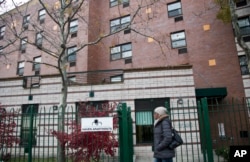The scene of neighbors hanging holiday decorations at their tidy New York City apartment building was nothing remarkable, except to the people doing it.
Like everyone else at Haven Apartments in the city's Bronx section, they had been homeless and mentally ill. And now they have their own apartments, in a building offering on-site help with everything from handling finances to managing medical care to making friends.
Facing a stubborn swell in homelessness, New York is embarking on what may be the biggest investment any city has made in places like Haven -- a $2.6 billion plan to create 15,000 “supportive housing'' apartments.
Advocates see the nation's fast-growing stock of supportive housing as a potent, cost-effective tool for getting people off the streets and into stable lives. And it has been that for Iris Soto, who moved into Haven from a homeless shelter in 2013.
”I feel like this is my family that I got here,'' said Soto, 59.
Staffers helped her cope with the depression that used to spur thoughts of hurting herself. Neighbors elected her president of a residents' council. And after years of bouncing between relatives' homes and shelters where she'd bathe at 4 a.m. because so many women jockeyed to wash up, she finally has a place of her own.
Yet some communities have shunned supportive housing, and some experts caution that it has limitations.
The upside
Dating to the 1980s, supportive housing has expanded from under 190,000 residents nationwide in 2007 to over 300,000 in 2014, federal statistics show. It's been credited with reducing chronic homelessness in Utah from 1,900 people to just 178 in a decade. Places from San Francisco to Massachusetts have major programs.
“It's more than just getting people out of sight by giving them a home,'' says Mary Brosnahan, president of the Coalition for the Homeless advocacy group. ``Because once they have that ... they can flip that switch from survival to working on thriving.''
New York is betting big on it at a time when homelessness has increased. About 58,000 people now rely on shelters — 12 percent more than two years ago — possibly thousands more live on the streets, and the city logged 60 percent more complaints about homelessness this year than last.
Homelessness has declined around the U.S. in recent years while rising in some places — Los Angeles and Hawaii recently declared it a state of emergency — as rents climbed ahead of incomes, among other likely factors.
New York Mayor Bill de Blasio announced his plan last month to nearly double the 32,000 existing supportive housing apartments citywide. The earlier ones were partly state-financed. The plan includes building 7,500 new apartments and designating 7,500 others scattered in various buildings, where social workers would visit regularly.
While residents generally pay a portion of their disability or other benefits in rent, the city expects to spend about $30,000 per apartment per year on services. Still, studies have found supportive housing saves thousands of dollars a year in shelter, hospital and jail costs.
The downside
Even as it's grown, supportive housing has faced pushback in places from Los Angeles to Dallas to the Chicago suburbs; prospective neighbors raised security fears or said they'd bear too much of their area's homelessness burden. De Blasio has said he's confident New York will find locations.
Some homelessness experts note the arrangement doesn't work for everyone, or everything.
Some residents end up getting evicted, going back to hospitals or simply abandoning their apartments — about 6 percent in one year in San Francisco, according to a San Francisco city comptroller's office report that also urged helping residents become self-sufficient enough to move out.
Haven Apartments is intended for two-to-five-year stays, but it's been 18 years and counting for Elaine Patterson. She says living there has made her “100 times stronger'' and opened new possibilities. These days, she writes poetry and volunteers at a library.
Robert Blake appreciates Haven, too, but he hopes his stay will be shorter. He used to live more independently in a “scattered'' supportive apartment, until a medication problem spurred several hospitalizations.
At Haven, he has gone three years without hospitalization. He's become more outgoing and even went to the state Capitol to lobby on social service issues with staffers from Haven's nonprofit operator, Unique People Services. A photo from the trip hangs in his small studio, alongside portraits of family.
“I had to come here to readjust myself ... see what I could learn and do,'' said Blake, 43. “Now I've reached a different level, and I'm ready to move on my own again.''











